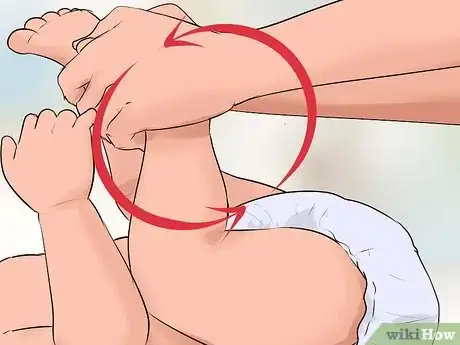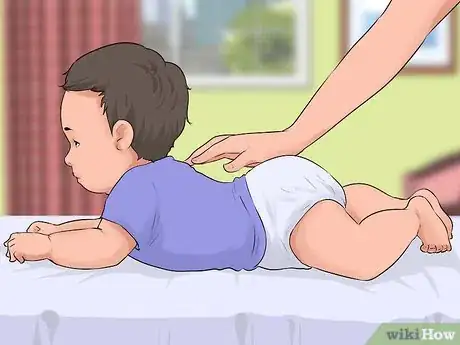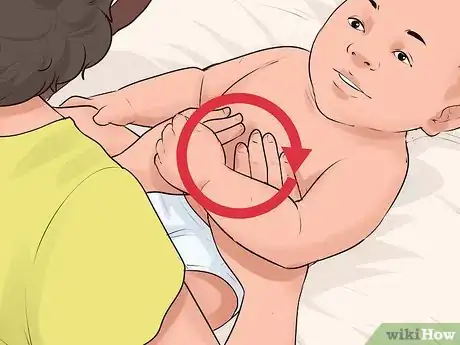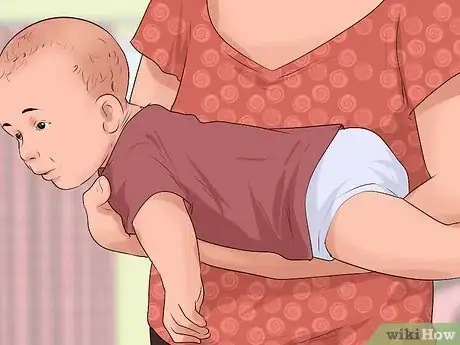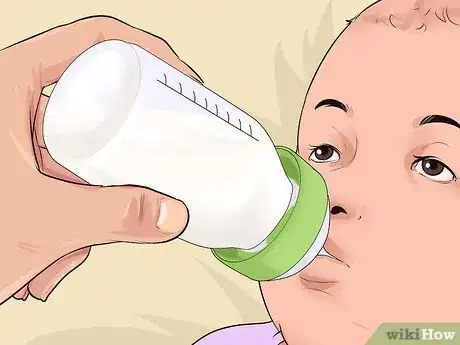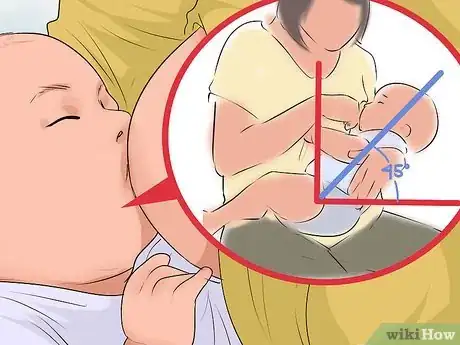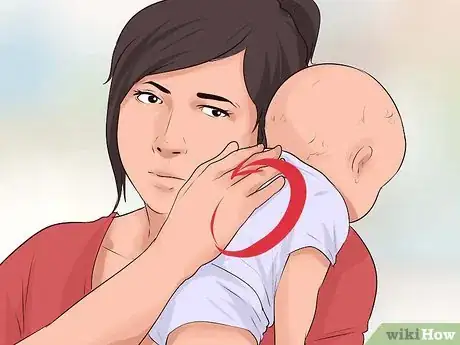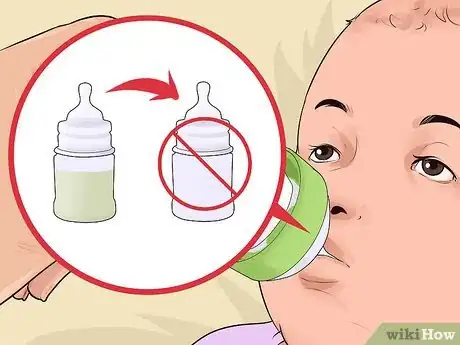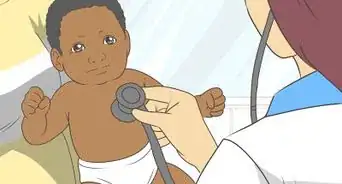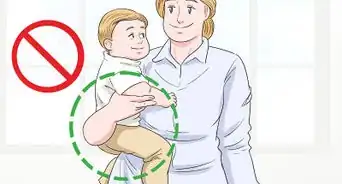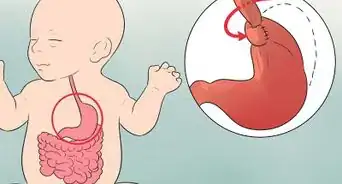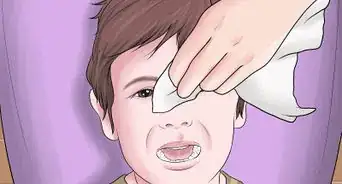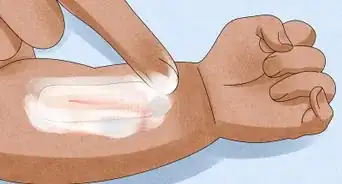This article was co-authored by Laura Marusinec, MD. Dr. Marusinec is a board certified Pediatrician at the Children's Hospital of Wisconsin, where she is on the Clinical Practice Council. She received her M.D. from the Medical College of Wisconsin School of Medicine in 1995 and completed her residency at the Medical College of Wisconsin in Pediatrics in 1998. She is a member of the American Medical Writers Association and the Society for Pediatric Urgent Care.
There are 10 references cited in this article, which can be found at the bottom of the page.
This article has been viewed 144,646 times.
Gas pain is a very common in babies and it can cause your baby—and you—discomfort.[1] Gas is often caused by swallowing air when crying or feeding or from the digestion process.[2] Even though gas can cause pain for your baby, it is generally harmless. By promoting the release of gas and preventing it, you can help relieve your baby’s gas.
Steps
Releasing Baby’s Gas
-
1Recognize the symptoms of gas. Although there is no evidence for a connection between colic, or excessive crying, and gas, some people may link the two conditions.[3] Identifying the signs of gas can help you quickly give your baby comfort. Symptoms of gas include:
- Pulling up her legs
- Clenching her fists
- Squirming around as if she’s uncomfortable
- Crying a lot
- Farting
- Burping[4]
-
2Do the bicycle with baby. If your baby seems gassy, lay her on her back on a stable surface. Then begin moving her legs in a bicycling motion to help move her intestines and expel the gas.[5]
- Move your baby’s legs gently so you don’t hurt her.
- Talk to your baby while you’re moving her legs. This may distract her from her pain and also comfort her.
Advertisement -
3Give her some tummy time. Every baby needs tummy time to strengthen their upper bodies and keep their heads from getting flat. But tummy time has the added benefit that it can help expel any gas that has settled in her stomach.[6]
-
4
-
5
-
6Rock, bounce, and hold your baby. Some babies expel gas when you move together with them or hold them in a certain way. Try rocking, bouncing, and the “gas hold” if your baby seems gassy.[15]
- Use the “gas hold” by holding your baby securely over your arm facing down. You can gently rock her in this position.[16]
- Rock your baby in a rocker or in your arms, which may move and expel gas.[17]
- Bounce your baby gently up and down. You can do this either while you’re standing or by sitting your baby on your lap and bouncing her.[18]
-
7Burst the bubbles with medication. Although studies suggest that they’re not really effective against gas, consider giving your baby anti-gas drops.[19] Doctors believe this treatment is safe up to 12 times a day, but be aware that drops can be expensive.[20]
- Look for anti-gas products with simethicone such as Mylicon, Little Tummies, or Phazyme.[21]
- Follow packaging instructions.
- Ask your pediatrician or pharmacist any questions you may have about the drops or using them.
-
8Consider probiotics. There is some evidence that probiotics, which help maintain “good” bacteria in the belly, can aid colic, which may reduce your baby’s gas.[22] Although experts haven’t recommended probiotic as a treatment for colic, consider giving your baby probiotics to relieve and prevent gas.[23]
-
9See your doctor. If moving and soothing your baby doesn’t seem to help relieve your baby’s gas, schedule an appointment with her doctor. She can rule out any diseases or intestinal issues that may be causing persistent gas.
- Tell your doctor what you’ve done to relieve the gas and if it is effective. Give the doctor any helpful information about your baby-- from eating to pooping habits.
Preventing Gas
-
1Soothe your baby if she is crying. Crying may cause your baby to swallow extra air, which can lead to gas. Do your best to soothe your baby when she starts to cry. Rock her in your arms, pat her on the back, talk in a soothing voice to her.
- You can also try to determine the reason why your baby is crying. For example, you baby might be crying because she is hungry, so feeding a little earlier than usual may help.[26]
-
2Feed effectively with a bottle. Babies who are bottle fed are often more prone to gas because of air in the bottle and nipple.[27] From holding the bottle at the proper angle to changing feeding frequency, making sure you optimize your baby’s bottle feeding experience can help prevent gas.[28]
- Feed your baby more often but decrease how much you give her so that there is less pressure in her belly.[29]
- Try out different sizes and types of bottles and nipples. Different models can slow the flow of liquid and the amount of air into her belly.[30]
- Tilt the bottle to a 30 or 40 degree angle so that the air rises to the bottom of the bottle.[31]
- Make sure your baby’s lip are on the wide base of the nipple and not just the tip.[32]
- Try a different type of formula after consulting with your doctor.[33]
- Allow the formula to settle after shaking or mixing it, or use a ready-to-feed formula.[34]
-
3Optimize your nursing experience. Breastfed babies may have less gas than bottle fed babies because the breast doesn’t trap air like a bottle. But as with bottle feeding, optimizing your technique may prevent gas in your baby.
- Nurse your baby more frequently during the day to reduce the amount she has in her belly.[35]
- Make sure your baby’s lips are sealed far back on your areola.[36]
- See what causes your baby’s gas by eliminating certain foods for two weeks. Common problem foods include broccoli, brussels sprouts, beans, cauliflower, cabbage, and onions.[37] Add food back in as you realize it doesn’t cause gas.[38] For example, cut out foods most likely to cause allergies like dairy, peanuts, tree nuts, soy, wheat and fish.[39]
-
4
-
5Burp your baby frequently. Step up your burping efforts by burping your baby during and after feedings.[43] This may break up any gas bubbles and prevent them from forming. However, you should be aware that it may upset your baby if you interrupt her feeding.[44] Try the following burping positions to prevent or relieve developing gas:
- Place your baby upright on your shoulder and pat her back.
- Sit her upright on your lap and lean her forward slightly while you rub or pat her back. Put your hand under her chin to support her chest and head.
- Lay your baby on her belly across your lap with her head slightly elevated while you rub and pat her back.[45]
-
6Discourage extensive sucking. Many babies are soothed by sucking on a pacifier or empty bottles nipples. Avoid allowing her to do this for prolonged periods of time to prevent gas.[46]
References
- ↑ http://www.thebump.com/a/gas-pain-baby
- ↑ http://www.parents.com/baby/care/gas/best-remedies-for-gas-reflux/
- ↑ http://americanpregnancy.org/first-year-of-life/colic/
- ↑ http://www.thebump.com/a/gas-pain-baby
- ↑ https://www.healthychildren.org/English/ages-stages/baby/diapers-clothing/Pages/Breaking-Up-Gas.aspx
- ↑ https://www.healthychildren.org/English/ages-stages/baby/diapers-clothing/Pages/Breaking-Up-Gas.aspx
- ↑ http://www.mayoclinic.org/healthy-lifestyle/infant-and-toddler-health/expert-answers/tummy-time/faq-20057755
- ↑ http://www.mayoclinic.org/healthy-lifestyle/infant-and-toddler-health/expert-answers/tummy-time/faq-20057755
- ↑ http://www.parents.com/baby/care/gas/best-remedies-for-gas-reflux/
- ↑ http://www.parents.com/baby/care/gas/best-remedies-for-gas-reflux/
- ↑ http://www.thebump.com/a/gas-pain-baby
- ↑ https://www.healthychildren.org/English/ages-stages/baby/diapers-clothing/Pages/Swaddling-Is-it-Safe.aspx
- ↑ https://www.healthychildren.org/English/ages-stages/baby/diapers-clothing/Pages/Swaddling-Is-it-Safe.aspx
- ↑ https://www.healthychildren.org/English/ages-stages/baby/diapers-clothing/Pages/Swaddling-Is-it-Safe.aspx
- ↑ http://www.parents.com/baby/care/gas/best-remedies-for-gas-reflux/
- ↑ http://www.parents.com/baby/care/gas/best-remedies-for-gas-reflux/
- ↑ http://www.thebump.com/a/gas-pain-baby
- ↑ http://www.thebump.com/a/gas-pain-baby
- ↑ https://www.healthychildren.org/English/ages-stages/baby/diapers-clothing/Pages/Breaking-Up-Gas.aspx
- ↑ https://www.healthychildren.org/English/ages-stages/baby/diapers-clothing/Pages/Breaking-Up-Gas.aspx
- ↑ https://www.healthychildren.org/English/ages-stages/baby/diapers-clothing/Pages/Breaking-Up-Gas.aspx
- ↑ http://www.mayoclinic.org/diseases-conditions/colic/basics/treatment/con-20019091
- ↑ http://www.mayoclinic.org/diseases-conditions/colic/basics/treatment/con-20019091
- ↑ http://www.mayoclinic.org/diseases-conditions/colic/basics/treatment/con-20019091
- ↑ http://www.mayoclinic.org/diseases-conditions/colic/basics/treatment/con-20019091
- ↑ http://www.parents.com/baby/care/gas/best-remedies-for-gas-reflux/
- ↑ http://www.healthline.com/health/gerd/infants-treatment#Feeding2
- ↑ http://www.askdrsears.com/topics/health-concerns/fussy-baby/comforting-gassy-baby
- ↑ http://www.askdrsears.com/topics/health-concerns/fussy-baby/comforting-gassy-baby
- ↑ https://www.healthychildren.org/English/ages-stages/baby/diapers-clothing/Pages/Breaking-Up-Gas.aspx
- ↑ http://www.askdrsears.com/topics/health-concerns/fussy-baby/comforting-gassy-baby
- ↑ http://www.askdrsears.com/topics/health-concerns/fussy-baby/comforting-gassy-baby
- ↑ https://www.healthychildren.org/English/ages-stages/baby/diapers-clothing/Pages/Breaking-Up-Gas.aspx
- ↑ https://www.healthychildren.org/English/ages-stages/baby/diapers-clothing/Pages/Breaking-Up-Gas.aspx
- ↑ http://www.askdrsears.com/topics/health-concerns/fussy-baby/comforting-gassy-baby
- ↑ http://www.askdrsears.com/topics/health-concerns/fussy-baby/comforting-gassy-baby
- ↑ http://www.parents.com/baby/care/gas/best-remedies-for-gas-reflux/
- ↑ https://www.healthychildren.org/English/ages-stages/baby/diapers-clothing/Pages/Breaking-Up-Gas.aspx
- ↑ http://www.mayoclinic.org/diseases-conditions/colic/basics/lifestyle-home-remedies/con-20019091
- ↑ http://www.mayoclinic.org/diseases-conditions/colic/basics/lifestyle-home-remedies/con-20019091
- ↑ http://www.askdrsears.com/topics/health-concerns/fussy-baby/comforting-gassy-baby
- ↑ http://www.mayoclinic.org/diseases-conditions/colic/basics/lifestyle-home-remedies/con-20019091
- ↑ https://www.healthychildren.org/English/ages-stages/baby/diapers-clothing/Pages/Breaking-Up-Gas.aspx
- ↑ https://www.healthychildren.org/English/ages-stages/baby/diapers-clothing/Pages/Breaking-Up-Gas.aspx
- ↑ https://www.healthychildren.org/English/ages-stages/baby/diapers-clothing/Pages/Breaking-Up-Gas.aspx
- ↑ http://www.askdrsears.com/topics/health-concerns/fussy-baby/comforting-gassy-baby

